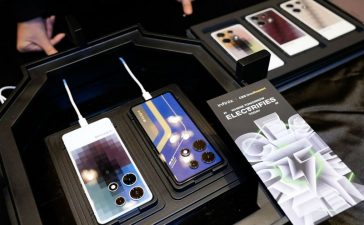-

Meta
Meta Quest 2
Quest 2 is an affordable and capable standalone headset that’s proved highly popular and has just got better and better since launch.
-

Meta
Meta Quest 3
Meta Quest 3 has improved visuals and comfort as well as the promise of colour passthrough and mixed reality experiences too.
On the same day as the Meta Gaming Showcase, Meta teased the launch of its upcoming headset, the Meta Quest 3.
The company says that the Quest 3 “will be the best way to experience mixed and virtual reality in a standalone device” as well as being compatible with Quest 2’s entire game library.
Based on this alone the Quest 3 might seem like a logical upgrade for Quest 2 owners or a sensible purchase for those wanting to get into VR. There are other things to consider though. Like what are the upgrades and how much will it set you back?
We’re here with all the details we know so far.
Price, specs & availability:
One of the most appealing things about the Quest 2 when it launched was the price tag. The Quest 2 launched at just $299, making it highly appealing as a standalone VR device that was also PC tetherable for PCVR experiences.
Since then Meta has actually raised the starting price of the Quest 2. In mid-2022 it was increased to $399. Still reasonably priced, especially compared to the high-end VR headsets available at the time.
Now with the announcement of the Quest 3, which Meta says is it’s “most powerful headset yet”, it’s perhaps no surprise to learn that the next standalone will cost even more.
The Quest 3 is set to start at $499/£499.99 for the 128GB model which we expect to mean that’ll be the base price with several models available. Likely with different prices based on internal storage as that’s the logic the company used with Quest 2 pricing.
There are several things to justify the price increase though.
Meta
Meta says that the Quest 3 is using the next generation of Qualcomm chipset, though there’s no official word on what that is yet. Though it could be the same Qualcomm Snapdragon XR2+ processor used on the Meta Quest Pro which was already a significant step up from the Quest 2.
There’s also the promise of “better displays and resolution” as well as twice the graphics performance which results in “jaw-dropping VR and breakthrough Meta reality”. Though there’s no official word on the screen specs, the current rumours around the Meta Quest 3 suggest that it could feature dual displays, which could either be LCD, OLED or Mini LED.
The displays could also support a resolution of 4,128 by 2,208 pixels (2,064 by 2,208 pixels per eye), though again that’s just the rumour at the moment. If true it’s a nice upgrade from the Quest 2’s 1832 x 1920 pixels per eye resolution.
We’ve heard that it will support a 120Hz refresh rate, which makes sense as the Quest 2 already does that.
Meta
Design and mixed reality changes
The Meta Quest 3 is visibly significantly different to the Meta Quest 2. It’s not just 40 per cent thinner but also sports an interesting front fascia design that includes three pills for tracking. These include dual 4MP RGB colour cameras and a depth sensor to help track your play space.
It’s said that these aid with inside-out tracking, as well as the new and improved colour video passthrough. That passthrough will include 10 times more pixels than the Quest 2.
Colour passthrough makes a big difference to user experience as it means you can see the world around you easily. It’s a great feature of the Quest Pro and one we look forward to seeing on the Meta Quest 3.
Meta
These cameras do more as well though, as Meta is saying that the Quest 3 includes “best-in-class Meta Reality technology” which means you’ll be able to pull mixed reality experiences into the real world around you. The headset will also use “innovative machine learning, and spatial understanding” to blend content with your world and create “limitless possibilities” of exploration.
On the underside of the Quest 3 there are three dots near the volume controls. These look like contact charging pins similar to those on the Quest Pro and could indicate there’s a charging base station of some sort coming with the Quest 3 or available to buy as an accessory.
The head strap has also been redesigned, though the rear-firing speakers are still there for built-in audio.
Meta
Controllers
The Quest 3 controllers are noticeably different to the Quest 2.
These are redesigned controllers that look similar to the Meta Quest Touch Pro controllers included with the Meta Quest Pro. Though they don’t appear to have the same charging connectors and are unlikely to include the same internal tech.
Meta does say that you will be able to upgrade to the Meta Quest Touch Pro Controllers for a premium experience with enhanced tracking.
However, the rings on the standard controllers are now gone and these new controllers look more ergonomic and comfortable. Meta says they also include TruTouch haptics that “provide a new level of interaction and reality, with localised trigger and thumb responses.”
Meta
The good news is Meta Quest 3 will launch with backward compatibility, meaning it’ll work with all the Quest 2 games. Which gives you access to well over 500 VR games, apps, and experiences. Plus more if you hook it up to a PC and play PCVR games.
Quest 3 is also launching with some of its own games as well, which will only be playable on that headset. These will be shown off at the Meta Gaming Showcase.
All this doesn’t mean that Meta Quest 2 is being neglected though. The company has said that from 4 June it’s reducing the price of Quest 2 to $299.99 USD for the 128GB SKU and $349.99 USD for the 256GB SKU.
Both the Quest 2 and Quest Pro are also getting some performance improvements in the upcoming software update too. With enhancements that will see as much as a 26% CPU performance increase with an up-to 19% GPU speed increase for Quest 2 and 11% for Quest Pro. Quest 2 is also getting Dynamic Resolution Scaling which should result in improved pixel density without sacrificing frame rates.
So if you don’t want to wait, the Quest 2 is still well worth a look.

















